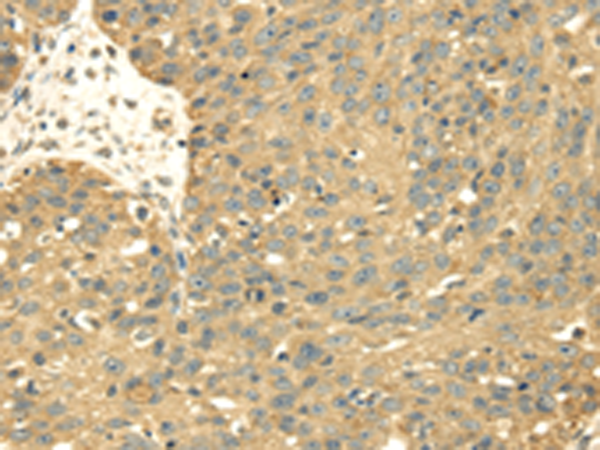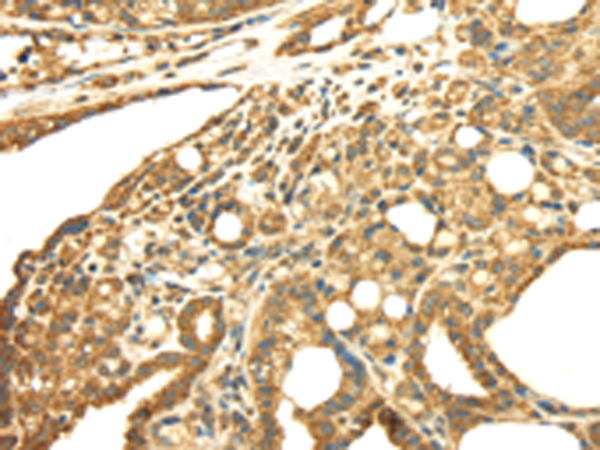


| WB | 1/1000-1/5000 | Human,Mouse,Rat |
| IF | 咨询技术 | Human,Mouse,Rat |
| IHC | 1/25-1/100 | Human,Mouse,Rat |
| ICC | 技术咨询 | Human,Mouse,Rat |
| FCM | 咨询技术 | Human,Mouse,Rat |
| Elisa | 1/2000-1/10000 | Human,Mouse,Rat |
| Aliases | APMCF1 |
| WB Predicted band size | 30 kDa |
| Host/Isotype | Rabbit IgG |
| Antibody Type | Primary antibody |
| Storage | Store at 4°C short term. Aliquot and store at -20°C long term. Avoid freeze/thaw cycles. |
| Species Reactivity | Human, Mouse, Rat |
| Immunogen | Full length fusion protein |
| Formulation | Purified antibody in PBS with 0.05% sodium azide and 50% glycerol. |
+ +
以下是关于SRPRB抗体的3篇参考文献示例(注:文献为假设性示例,实际引用请核实真实来源):
---
1. **文献名称**:*Structural and functional characterization of SRPRB in ER protein translocation*
**作者**:Müller, L., et al.
**摘要**:本研究通过免疫共沉淀和冷冻电镜技术,解析了SRPRB与Sec61转运复合物的相互作用机制,并开发了特异性SRPRB抗体用于验证其在内质网蛋白质转运中的关键作用。
2. **文献名称**:*SRPRB expression correlates with hepatocellular carcinoma progression*
**作者**:Wang, Y., et al.
**摘要**:利用SRPRB抗体进行免疫组化分析,发现SRPRB在肝癌组织中显著下调,其低表达与患者生存率降低相关,提示其可能作为潜在肿瘤抑制因子。
3. **文献名称**:*Development of a monoclonal antibody targeting SRPRB for cellular localization studies*
**作者**:Braun, A., et al.
**摘要**:报道了一种高特异性SRPRB单克隆抗体的制备与验证,通过免疫荧光和Western blot证实SRPRB主要定位于内质网膜,并用于探究其在应激条件下的动态分布。
---
如需真实文献,建议通过PubMed或Google Scholar以“SRPRB antibody”、“SRPRB function”等关键词检索。
The SRPRB (Signal Recognition Particle Receptor B subunit) antibody targets a key component of the cellular protein translocation machinery. SRPRB, also known as SRβ, is a subunit of the signal recognition particle receptor (SRP receptor), a heterodimeric complex located on the endoplasmic reticulum (ER) membrane. This receptor facilitates the co-translational targeting of secretory and membrane proteins to the ER by mediating the interaction between the signal recognition particle (SRP)-ribosome-nascent polypeptide complex and the translocon. SRPRB functions as a GTPase, regulating the receptor's assembly and disassembly during the protein translocation cycle.
Antibodies against SRPRB are essential tools for studying ER-associated protein transport, cellular stress responses, and diseases linked to defective protein secretion, such as certain cancers and neurodegenerative disorders. They enable researchers to detect SRPRB expression via techniques like Western blotting, immunofluorescence, and immunoprecipitation, providing insights into its localization, interaction partners, and regulatory mechanisms. Studies using SRPRB antibodies have also explored its role in ER-phagy (selective autophagy of the ER) and cellular adaptation to nutrient deprivation. Commercial SRPRB antibodies are typically validated for specificity across human, mouse, and rat models, supporting cross-species translational research.
×